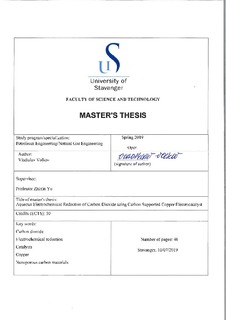| dc.description.abstract | The atmospheric concentration of CO2 has been rising progressively from 280 parts per million (ppm) in the pre-industrial time to 410 ppm in 2018. The anthropogenic CO2 emissions are dominated by fossil fuel sources, which has led to increasing interest in carbon capture and storage and CO2 utilization technologies. One approach for CO2 utilization is the electrochemical reduction of CO2. Advantages of electrochemical reduction of CO2 include the modular and compact design that allows for easy scale-up, generates low amounts of waste, and the process is easily controlled. However, a key challenge for developing viable CO2 reduction processes is the discovery of affordable, efficient, selective, and stable catalysts.
Copper is an interesting metal for electrochemical reduction of CO2 because it can produce a range of different products such as hydrocarbons, alcohols, formate, and carbon monoxide. The challenge is to find suitable modifiers that can improve the selectivity towards the desired product. Carbon supported metallic nanoparticles has emerged as a promising candidate for electrochemical reduction of CO2. So far, only a few works have investigated the carbon supported Cu nanoparticles. These studies have found that the selectivity and the faradaic efficiency of Cu can be improved by the carbon support.
In this thesis, the activities of Cu nanoparticles supported on different multi-walled carbon nanotubes (MWCNT1020 and MWCNT2040) and Ketjenblack (KB) toward electrochemical reduction of CO2 with emphasis on formic acid and methanol production. The catalysts were prepared by the homogeneous deposition precipitation method and characterized by thermal gravimetry, X-ray diffraction, scanning electron microscopy, Raman spectroscopy, and X-ray photoelectric spectroscopy. The faradaic efficiency was highest for H2, followed by HCOOH. The activity of MWCNT supported Cu (Cu = 5, 10, and 20 wt. %) with different loading showed that the highest faradaic efficiency was obtained at 20 wt. %. Furthermore, only small changes in product selectivity were observed. Comparing two different MWCNTs and KB showed that the support could have an impact on the product selectivity. It was found that the MWCNT1020 had a higher oxygen content than the other carbon supports and generated a significant amount of methanol. Moreover, the MWCNT1020 supported Cu catalyst achieved the highest total faradaic efficiency. The results suggest that the carbon support can play a significant role in catalytic performance for electrochemical reduction of CO2 to formic acid and methanol. | nb_NO |
